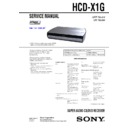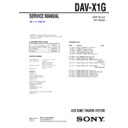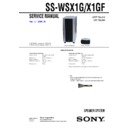Read Sony DAV-X1G / HCD-X1G Service Manual online
SERVICE MANUAL
SUPER AUDIO CD/DVD RECEIVER
HCD-X1G
Ver. 1.0 2006.07
SPECIFICATIONS
Model Name Using Similar Mechanism
HCD-X1
DVD Mechanism Type
CDM85-DVBU102
Optical Pick-Up Block Name
KHM-310CAA or KHM-313CAA
– Continued on next page –
AEP Model
UK Model
9-887-337-01
2006G05-1
© 2006.07
© 2006.07
Sony Corporation
Home Audio Division
Published by Sony Techno Create Corporation
Published by Sony Techno Create Corporation
This system incorporates with Dolby*
1
Digital
and Dolby Pro Logic (II) adaptive matrix
surround decoder and the DTS*
surround decoder and the DTS*
2
Digital
Surround System.
This system perfectly decodes 5.1 channel
signal, but you cannot add other commercially
available surround speakers.
signal, but you cannot add other commercially
available surround speakers.
*1 Manufactured under license from Dolby
Laboratories.
“Dolby,” “Pro Logic,” and the double-D symbol are
trademarks of Dolby Laboratories.
“Dolby,” “Pro Logic,” and the double-D symbol are
trademarks of Dolby Laboratories.
*2 Manufactured under license from Digital Theater
Systems, Inc.
“DTS” and “DTS Digital Surround” are registered
trademarks of Digital Theater Systems, Inc.
“DTS” and “DTS Digital Surround” are registered
trademarks of Digital Theater Systems, Inc.
Amplifier section
Front
Power output (rated): 40 W
+ 40 W (6 ohms, 1 kHz,
THD 1 %)
Continuous RMS power
output (reference): 50 W +
50 W (6 ohms at 1 kHz,
THD 10 %)
+ 40 W (6 ohms, 1 kHz,
THD 1 %)
Continuous RMS power
output (reference): 50 W +
50 W (6 ohms at 1 kHz,
THD 10 %)
Front surround*
Power output (rated): 40 W
+ 40 W (6 ohms, 1 kHz,
THD 1 %)
Continuous RMS power
output (reference): 50 W +
50 W (6 ohms at 1 kHz,
THD 10 %)
+ 40 W (6 ohms, 1 kHz,
THD 1 %)
Continuous RMS power
output (reference): 50 W +
50 W (6 ohms at 1 kHz,
THD 10 %)
Subwoofer
Power output (rated): 40 W
+ 40 W (6 ohms, 100 Hz,
THD 1 %)
Continuous RMS power
output (reference): 50 W +
50 W (6 ohms at 100 Hz,
THD 10 %)
+ 40 W (6 ohms, 100 Hz,
THD 1 %)
Continuous RMS power
output (reference): 50 W +
50 W (6 ohms at 100 Hz,
THD 10 %)
* Depending on the source, there may be no sound
output.
Inputs (Analogue)
VIDEO 1/SAT 1, VIDEO 2/SAT 2
VIDEO 1/SAT 1, VIDEO 2/SAT 2
Sensitivity: 250/450 mV
RMS
Impedance: 50 kilohms
RMS
Impedance: 50 kilohms
TV
Sensitivity: 450 mV RMS
Impedance: 50 kilohms
Impedance: 50 kilohms
Inputs (Digital)
VIDEO 1/SAT 1, VIDEO 2/SAT 2, TV
VIDEO 1/SAT 1, VIDEO 2/SAT 2, TV
Impedance: 75 ohms
Super Audio CD/DVD system
Laser
Semiconductor laser
(DVD:
λ = 650 nm)
(CD:
λ = 790 nm)
Emission duration:
continuous
continuous
Signal format system
NTSC/PAL
Tuner section
System
PLL quartz-locked digital
synthesizer system
synthesizer system
FM tuner section
Tuning range
Tuning range
87.5
− 108.0 MHz
(50 kHz step)
Antenna (aerial)
FM wire antenna (aerial)
Antenna (aerial) terminals 75 ohms, unbalanced
Intermediate frequency
Intermediate frequency
10.7 MHz
AM tuner section
Tuning range
Tuning range
531
− 1,602kHz (with the
interval set at 9 kHz)
Antenna (aerial)
AM loop antenna (aerial)
Intermediate frequency
450 kHz
•
HCD-X1G is the amplifier, super audio CD/DVD
system, tuner and video section in DAV-X1G.
system, tuner and video section in DAV-X1G.
2
HCD-X1G
Notes on chip component replacement
• Never reuse a disconnected chip component.
• Notice that the minus side of a tantalum capacitor may be
damaged by heat.
Flexible Circuit Board Repairing
• Keep the temperature of the soldering iron around 270 ˚C
during repairing.
• Do not touch the soldering iron on the same conductor of the
circuit board (within 3 times).
• Be careful not to apply force on the conductor when soldering
or unsoldering.
CAUTION
Use of controls or adjustments or performance of procedures
other than those specified herein may result in hazardous radiation
exposure.
other than those specified herein may result in hazardous radiation
exposure.
SAFETY-RELATED COMPONENT WARNING!!
COMPONENTS IDENTIFIED BY MARK
0
OR DOTTED LINE
WITH MARK
0
ON THE SCHEMATIC DIAGRAMS AND IN
THE PARTS LIST ARE CRITICAL TO SAFE OPERATION.
REPLACE THESE COMPONENTS WITH SONY PARTS WHOSE
PART NUMBERS APPEAR AS SHOWN IN THIS MANUAL OR
IN SUPPLEMENTS PUBLISHED BY SONY.
REPLACE THESE COMPONENTS WITH SONY PARTS WHOSE
PART NUMBERS APPEAR AS SHOWN IN THIS MANUAL OR
IN SUPPLEMENTS PUBLISHED BY SONY.
Video section
Outputs
Video: 1 Vp-p 75 ohms
S video:
Y: 1 Vp-p 75 ohms
C: 0.286 Vp-p 75 ohms
COMPONENT:
Y: 1 Vp-p 75 ohms
S video:
Y: 1 Vp-p 75 ohms
C: 0.286 Vp-p 75 ohms
COMPONENT:
Y: 1 Vp-p 75 ohms
P
B
/C
B
, P
R
/C
R
: 0.7 Vp-p
75 ohms
Input
VIDEO: 1 Vp-p 75 ohms
S video:
Y: 1 Vp-p 75 ohms
C: 0.286 Vp-p 75 ohms
S video:
Y: 1 Vp-p 75 ohms
C: 0.286 Vp-p 75 ohms
General
Power requirements
220
− 240 V AC, 50/60 Hz
Power consumption
On: 85 W
Standby: 0.3 W (at the
Power Saving Mode)
Standby: 0.3 W (at the
Power Saving Mode)
Dimensions (approx.)
380
× 76 293 mm (w/h/d)
incl. projecting parts
Mass (approx.)
4.5 kg
Design and specifications are subject to change
without notice.
without notice.
This appliance is
classified as a CLASS 1
LASER product. This
marking is located on the
bottom of the unit.
classified as a CLASS 1
LASER product. This
marking is located on the
bottom of the unit.
SELF DIAGNOSIS FUNCTION
When the self-diagnosis function is activated to
prevent the system from malfunctioning, a 5-
character service number (e.g., C 13 50) with a
combination of a letter and 4 digits appears on
the screen and the front panel display. In this
case, check the following table.
prevent the system from malfunctioning, a 5-
character service number (e.g., C 13 50) with a
combination of a letter and 4 digits appears on
the screen and the front panel display. In this
case, check the following table.
(When letters/numbers appear in the
display)
display)
First 3
characters of
the service
number
characters of
the service
number
Cause and/or corrective action
C 13
The disc is dirty.
,Clean the disc with a soft cloth
C 31
The disc is not inserted correctly.
,Restart the system, then re-insert
the disc correctly.
E XX
(xx is a number)
To prevent a malfunction, the
system has performed the self-
diagnosis function.
system has performed the self-
diagnosis function.
,Contact your nearest Sony
dealer or local authorized Sony
service facility and give the 5-
character service number.
service facility and give the 5-
character service number.
Example: E 61 10
C:13:50
3
HCD-X1G
TABLE OF CONTENTS
1.
SERVICING NOTES
...............................................
4
2.
GENERAL
...................................................................
9
3.
DISASSEMBLY
3-1.
Disassembly Flow ........................................................... 11
3-2.
Optical Pick-up Block
(KHM-310CAA or KHM-313CAA) ............................... 11
(KHM-310CAA or KHM-313CAA) ............................... 11
3-3.
Side Panel (L/R) .............................................................. 12
3-4.
Case (AL) ........................................................................ 12
3-5.
Front Panel Section ......................................................... 13
3-6.
MAIN Board .................................................................... 14
3-7.
D.C. Fan (M450), Back Panel Section and
Sheet (main) .................................................................... 14
Sheet (main) .................................................................... 14
3-8.
DVD Mechanism Deck (CDM85-DVBU102) ................ 15
3-9.
Chuck Cam, Belt ............................................................. 16
4.
TEST MODE
.............................................................. 17
5.
DIAGRAMS
5-1.
Block Diagram – RF SERVO/VIDEO Section – ............ 21
5-2.
Block Diagram – MAIN Section – .................................. 22
5-3.
Block Diagram – AMP Section – .................................... 23
5-4.
Block Diagram
– PANEL/POWER SUPPLY Section – ........................... 24
– PANEL/POWER SUPPLY Section – ........................... 24
5-5.
Printed Wiring Boards – DMB10 Section (1/2) – ........... 26
5-6.
Printed Wiring Board – DMB10 Section (2/2) – ............. 27
5-7.
Schematic Diagram – DMB10 Section (1/4) – ............... 28
5-8.
Schematic Diagram – DMB10 Section (2/4) – ............... 29
5-9.
Schematic Diagram – DMB10 Section (3/4) – ............... 30
5-10. Schematic Diagram – DMB10 Section (4/4) – ............... 31
5-11. Schematic Diagram – IO Board – ................................... 33
5-12. Printed Wiring Board
5-11. Schematic Diagram – IO Board – ................................... 33
5-12. Printed Wiring Board
– IO Board (Component Side) – ...................................... 34
5-13. Printed Wiring Board
– IO Board (Conductor Side) – ....................................... 35
5-14. Printed Wiring Board – SCART Board – ........................ 36
5-15. Schematic Diagram – SCART Board – ........................... 37
5-16. Printed Wiring Board
5-15. Schematic Diagram – SCART Board – ........................... 37
5-16. Printed Wiring Board
– MAIN Board (Component Side) – ............................... 38
5-17. Printed Wiring Board
– MAIN Board (Conductor Side) – ................................. 39
5-18. Schematic Diagram – MAIN Board (1/4) – .................... 40
5-19. Schematic Diagram – MAIN Board (2/4) – .................... 41
5-20. Schematic Diagram – MAIN Board (3/4) – .................... 42
5-21. Schematic Diagram – MAIN Board (4/4) – .................... 43
5-22. Printed Wiring Board – SWITCH Board – ..................... 44
5-23. Schematic Diagram – SWITCH Board – ........................ 45
5-24. Printed Wiring Board – FL Board – ................................ 46
5-25. Schematic Diagram – FL Board – ................................... 47
5-26. Printed Wiring Board
5-19. Schematic Diagram – MAIN Board (2/4) – .................... 41
5-20. Schematic Diagram – MAIN Board (3/4) – .................... 42
5-21. Schematic Diagram – MAIN Board (4/4) – .................... 43
5-22. Printed Wiring Board – SWITCH Board – ..................... 44
5-23. Schematic Diagram – SWITCH Board – ........................ 45
5-24. Printed Wiring Board – FL Board – ................................ 46
5-25. Schematic Diagram – FL Board – ................................... 47
5-26. Printed Wiring Board
– POWER-AMP Board (Component Side) – .................. 48
5-27. Printed Wiring Board
– POWER-AMP Board (Conductor Side) – .................... 49
5-28. Schematic Diagram – POWER-AMP Board (1/3) – ....... 50
5-29. Schematic Diagram – POWER-AMP Board (2/3) – ....... 51
5-30. Schematic Diagram – POWER-AMP Board (3/3) – ....... 52
5-29. Schematic Diagram – POWER-AMP Board (2/3) – ....... 51
5-30. Schematic Diagram – POWER-AMP Board (3/3) – ....... 52
6.
EXPLODED VIEWS
6-1.
Case (AL), Side Panel Section ........................................ 73
6-2.
Front Panel Section ......................................................... 74
6-3.
MAIN Board Section ....................................................... 75
6-4.
POWER-AMP Board Section ......................................... 76
6-5.
Chassis Section ................................................................ 77
6-6.
DVD Mechanism Deck Section (CDM85-DVBU102) ... 78
7.
ELECTRICAL PARTS LIST
................................ 79
4
HCD-X1G
The laser diode in the optical pick-up block may suffer electrostatic
break-down because of the potential difference generated by the
charged electrostatic load, etc. on clothing and the human body.
During repair, pay attention to electrostatic break-down and also
use the procedure in the printed matter which is included in the
repair parts.
The flexible board is easily damaged and should be handled with
care.
break-down because of the potential difference generated by the
charged electrostatic load, etc. on clothing and the human body.
During repair, pay attention to electrostatic break-down and also
use the procedure in the printed matter which is included in the
repair parts.
The flexible board is easily damaged and should be handled with
care.
NOTES ON LASER DIODE EMISSION CHECK
The laser beam on this model is concentrated so as to be focused on
the disc reflective surface by the objective lens in the optical pick-
up block. Therefore, when checking the laser diode emission,
observe from more than 30 cm away from the objective lens.
the disc reflective surface by the objective lens in the optical pick-
up block. Therefore, when checking the laser diode emission,
observe from more than 30 cm away from the objective lens.
UNLEADED SOLDER
Boards requiring use of unleaded solder are printed with the lead-
free mark (LF) indicating the solder contains no lead.
(Caution: Some printed circuit boards may not come printed with
free mark (LF) indicating the solder contains no lead.
(Caution: Some printed circuit boards may not come printed with
the lead free mark due to their particular size)
: LEAD FREE MARK
Unleaded solder has the following characteristics.
•
Unleaded solder melts at a temperature about 40 ˚C higher
than ordinary solder.
Ordinary soldering irons can be used but the iron tip has to be
applied to the solder joint for a slightly longer time.
Soldering irons using a temperature regulator should be set to
about 350 ˚C.
Caution: The printed pattern (copper foil) may peel away if
Caution: The printed pattern (copper foil) may peel away if
the heated tip is applied for too long, so be careful!
•
Strong viscosity
Unleaded solder is more viscou-s (sticky, less prone to flow)
Unleaded solder is more viscou-s (sticky, less prone to flow)
than ordinary solder so use caution not to let solder bridges
occur such as on IC pins, etc.
occur such as on IC pins, etc.
•
Usable with ordinary solder
It is best to use only unleaded solder but unleaded solder may
It is best to use only unleaded solder but unleaded solder may
also be added to ordinary solder.
RELEASING THE TRAY LOCK
The disc tray lock function for the antitheft of an demonstration
disc in the store is equipped.
disc in the store is equipped.
Releasing Procedure :
1. Press the
I
/1
button to turn the power on.
2. Press the [FUNCTION] button to select the “DVD”.
3. While pressing the
3. While pressing the
x
button, press the
Z
button until
“UNLOCKED” displayed on the fluorescent indicator tube
(around 5 seconds).
(around 5 seconds).
Note:
When “LOCKED” is displayed, the tray lock is not released by turning
power on/off with the
power on/off with the
I/
1
button.
RELEASING THE DEMO PLAY LOCK
Releasing Procedure :
1. Press the
I
/1
button to turn the power on.
2. Press the [FUNCTION] button to select the “DVD”.
3. While pressing the
3. While pressing the
x
button, press the
N
button until
“DEMO OFF” displayed on the fluorescent indicator tube
(around 5 seconds).
(around 5 seconds).
Note:
When “DEMO PLAY” is displayed, the DEMO play lock is not
released by turning power on/off with the
released by turning power on/off with the
I/
1
button.
NOTES ON HANDLING THE OPTICAL PICK-UP
BLOCK OR BASE UNIT
BLOCK OR BASE UNIT
SECTION 1
SERVICING NOTES
NOTE OF REPLACING THE DMB10 BOARD (Part No.
A-1107-248-A)
A-1107-248-A)
New part of EEPROM (IC103) on the DMB10 board cannot be
used. Therefore, if the mounted DMB10 board is replaced, exchange
new EEPROM with that used before the replacement.
used. Therefore, if the mounted DMB10 board is replaced, exchange
new EEPROM with that used before the replacement.
S-FORCE FRONT SURROUND OPERATION CHECK
When complaint by the effect of the sound field, check as follows
and confirm abnormality is not found in the set.
and confirm abnormality is not found in the set.
Procedure:
1
Press
Z
on the system.
2
Load the Setup Disc.
Place the Setup Disc on the tray, and then press Z on the
system.
system.
The Setup Disc menu appears.
3
Sit in the listening position, then select one of the three
options on the screen using
options on the screen using
C/c
, and press
H
or
ENTER.
The selected option starts.
4
Listening carefully to how the option sounds to
determine the optimal surround sound effect.
determine the optimal surround sound effect.
If a satisfactory surround sound effect cannot be achieved,
adjust the speaker positions.
adjust the speaker positions.
5
Press
x
to stop the disc.
6
Press
Z
on the system to eject the disc.
DAV-X1 / DAR-X1 Series
This setup disc is common for DAV-X1/DAR-X1 series.
RL
RR
FL
FR
C
SW



